History of Art: Essential Concepts for Reading Comprehension
📋 Overview:
The history of art explores how human creativity has evolved, reflecting societal, cultural, and philosophical changes over centuries. From the realism of the Renaissance to the experimental nature of contemporary art, each movement offers insights into the values and challenges of its time. RC passages on this topic often analyze artistic styles, their historical contexts, and their cultural significance. Understanding these concepts allows readers to critically evaluate the evolution of artistic expression across time and regions.
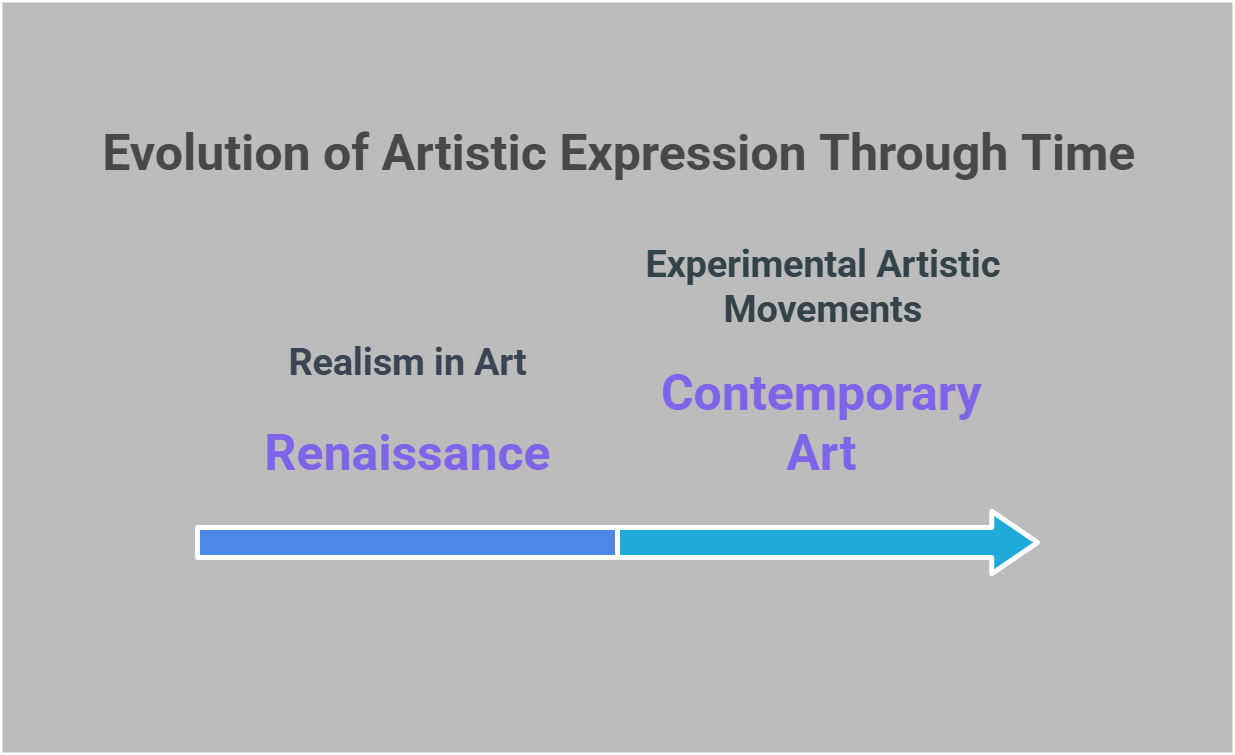
🔑 Key Concepts:
This guide explores the following essential concepts in the history of art:
- Renaissance Art
- Impressionism
- Cubism
- Surrealism
- Abstract Expressionism
- Baroque Art
- Romanticism
- Contemporary Art
- Art Criticism
- Non-Western Art Traditions
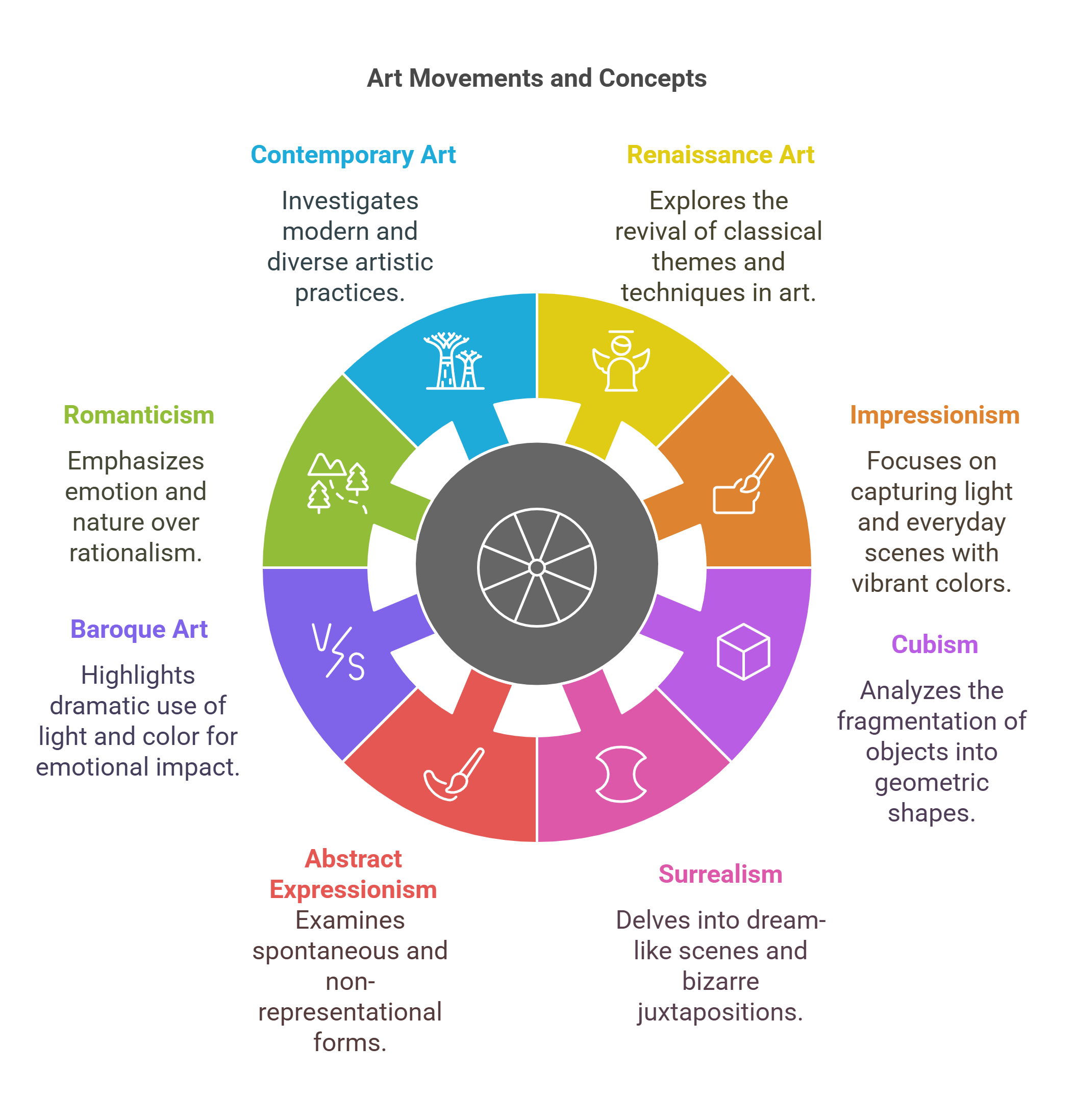
🔍 Detailed Explanations
1. Renaissance Art
Detailed Explanation: The Renaissance (14th–17th centuries) marked a rebirth of classical learning and humanism in Europe. Artists focused on realism, perspective, and the human form, celebrating individuality and intellectual achievement.
- Key Characteristics:
- Use of linear perspective to create depth.
- Emphasis on anatomy and naturalism in figures.
- Inspiration from classical antiquity (Greek and Roman art).
- Famous Artists:
- Leonardo da Vinci (Mona Lisa, The Last Supper).
- Michelangelo (David, Sistine Chapel ceiling).
- Raphael (The School of Athens).
- Impact:
- Transformed art into a vehicle for humanistic thought.
- Influenced subsequent movements, including Baroque and Romanticism.
Explained Simply: Renaissance art was like putting the human spirit at the center of the canvas, blending science, emotion, and beauty.
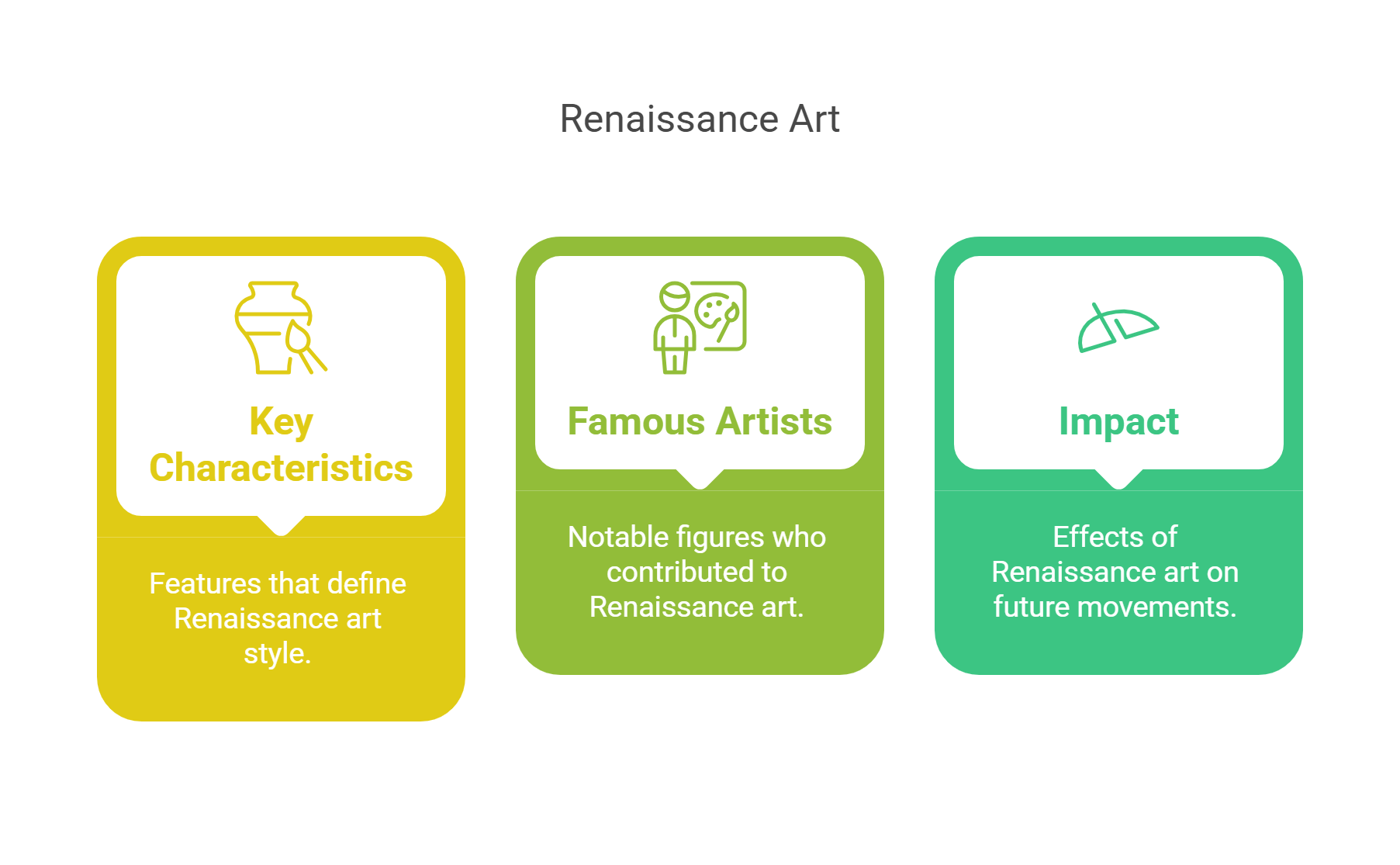
2. Impressionism
Detailed Explanation: Impressionism (late 19th century) originated in France as a reaction against traditional academic art. Artists sought to capture fleeting moments, emphasizing light and color over precise detail.
- Key Characteristics:
- Loose, visible brushstrokes.
- Focus on outdoor scenes and natural light (plein air painting).
- Interest in ordinary, everyday subjects.
- Famous Artists:
- Claude Monet (Impression, Sunrise).
- Pierre-Auguste Renoir (Luncheon of the Boating Party).
- Edgar Degas (The Ballet Class).
- Impact:
- Challenged traditional art norms, paving the way for modern art movements.
- Inspired Post-Impressionists like Vincent van Gogh and Paul Cézanne.
Explained Simply: Impressionism is like capturing the world in fleeting snapshots of light and color.
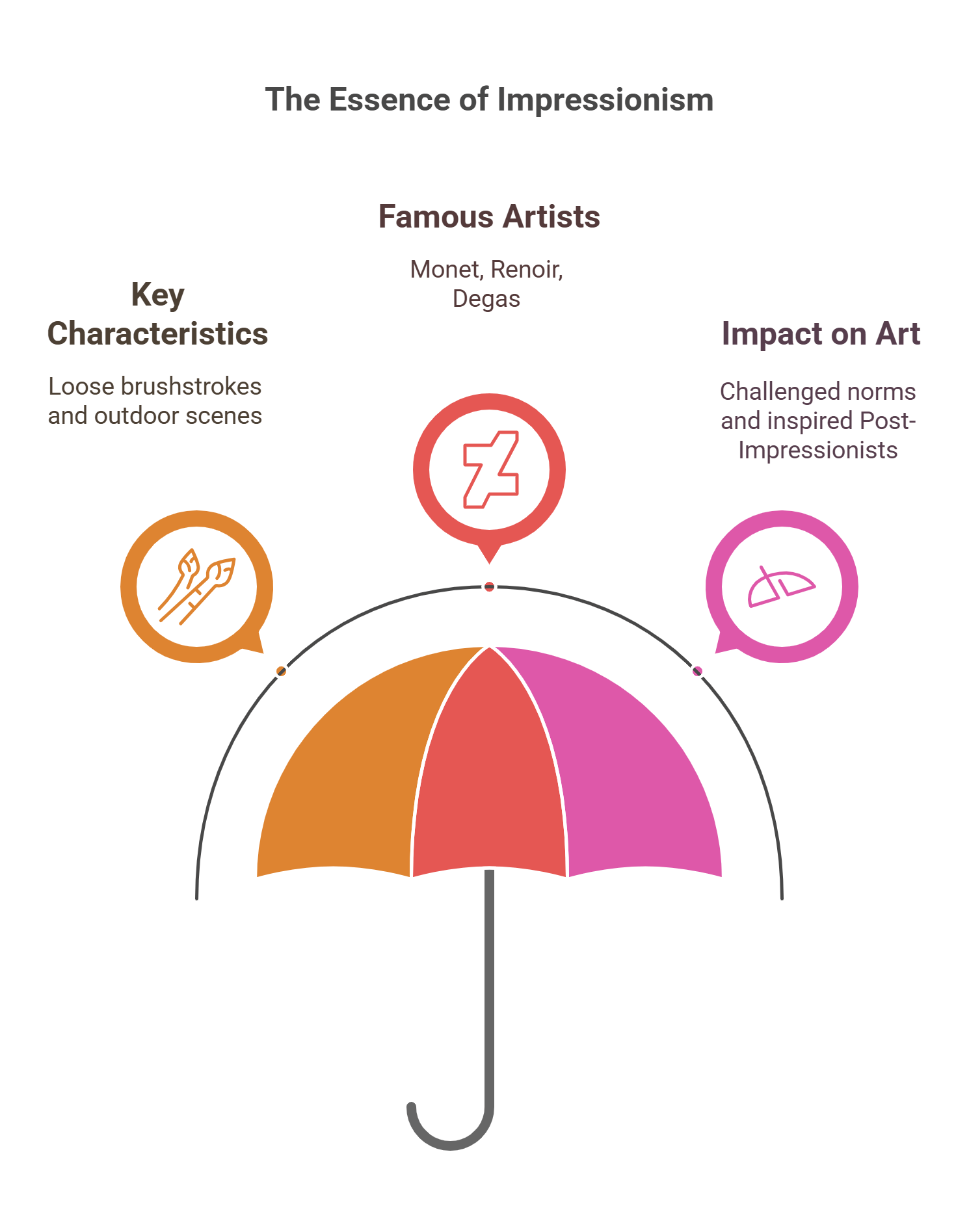
3. Cubism
Detailed Explanation: Cubism (early 20th century) revolutionized art by breaking objects into geometric shapes and presenting multiple perspectives simultaneously. Developed in France, it rejected traditional notions of depth and form.
- Key Characteristics:
- Fragmentation of objects into abstracted forms.
- Flattened, two-dimensional spaces.
- Use of monochromatic or muted color palettes.
- Famous Artists:
- Pablo Picasso (Les Demoiselles d’Avignon).
- Georges Braque (Violin and Candlestick).
- Impact:
- Influenced movements like Futurism, Constructivism, and Abstract Art.
- Redefined artistic representation, focusing on intellectual interpretation rather than realism.
Explained Simply: Cubism is like looking at the world through a kaleidoscope, where shapes and angles reveal new meanings.
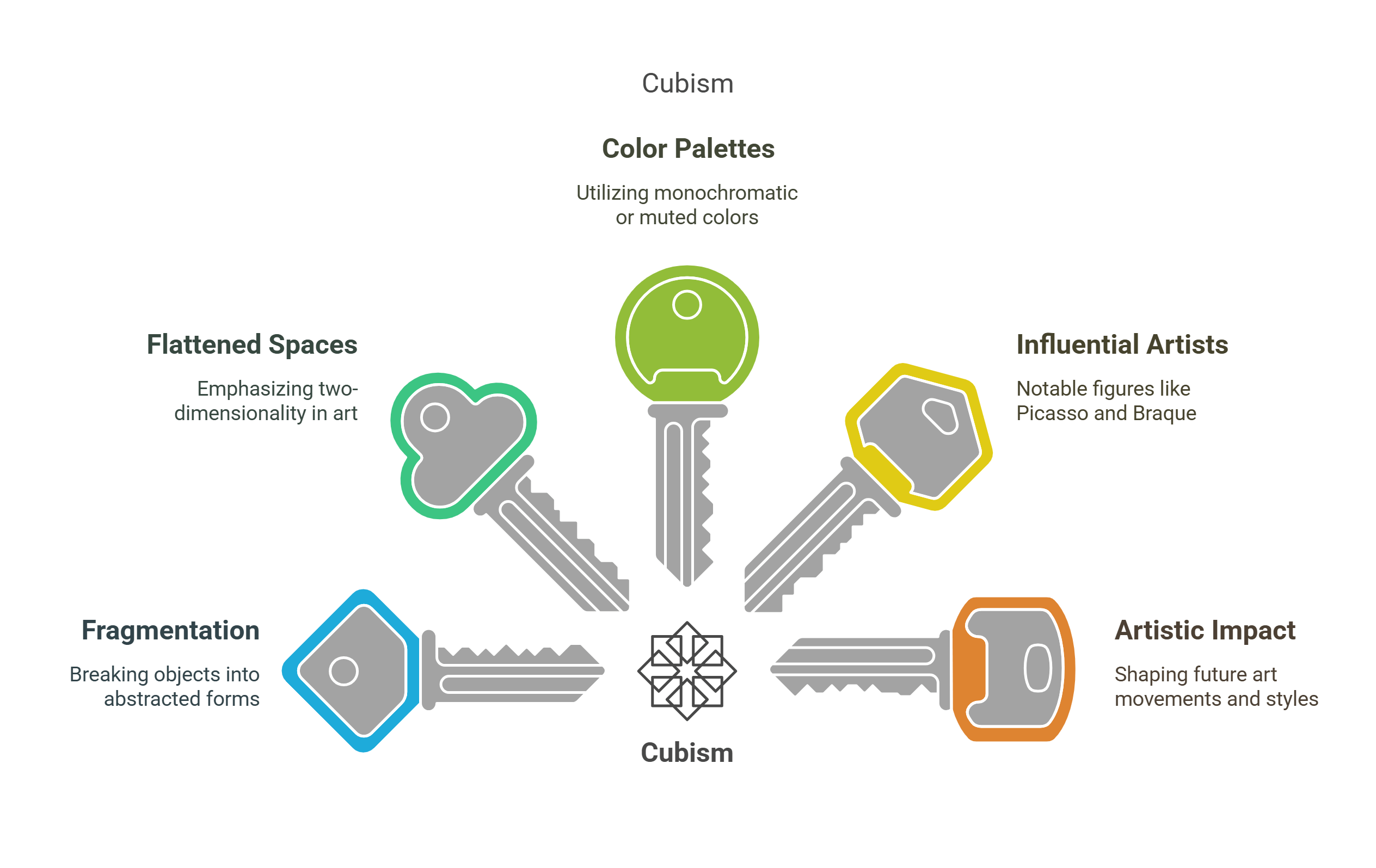
4. Surrealism
Detailed Explanation: Surrealism (1920s–1940s) sought to unlock the unconscious mind, merging dreams and reality in imaginative and unexpected ways. Influenced by Freud’s theories of psychoanalysis, it emphasized irrationality and spontaneity.
- Key Characteristics:
- Juxtaposition of unrelated objects to create dreamlike imagery.
- Exploration of subconscious thoughts and emotions.
- Use of symbolism to evoke mystery and ambiguity.
- Famous Artists:
- Salvador Dalí (The Persistence of Memory).
- René Magritte (The Son of Man).
- Max Ernst (Two Children Are Threatened by a Nightingale).
- Impact:
- Expanded artistic expression into psychological and emotional realms.
- Influenced film, literature, and theater.
Explained Simply: Surrealism is like stepping into a vivid dream, where the impossible becomes tangible.
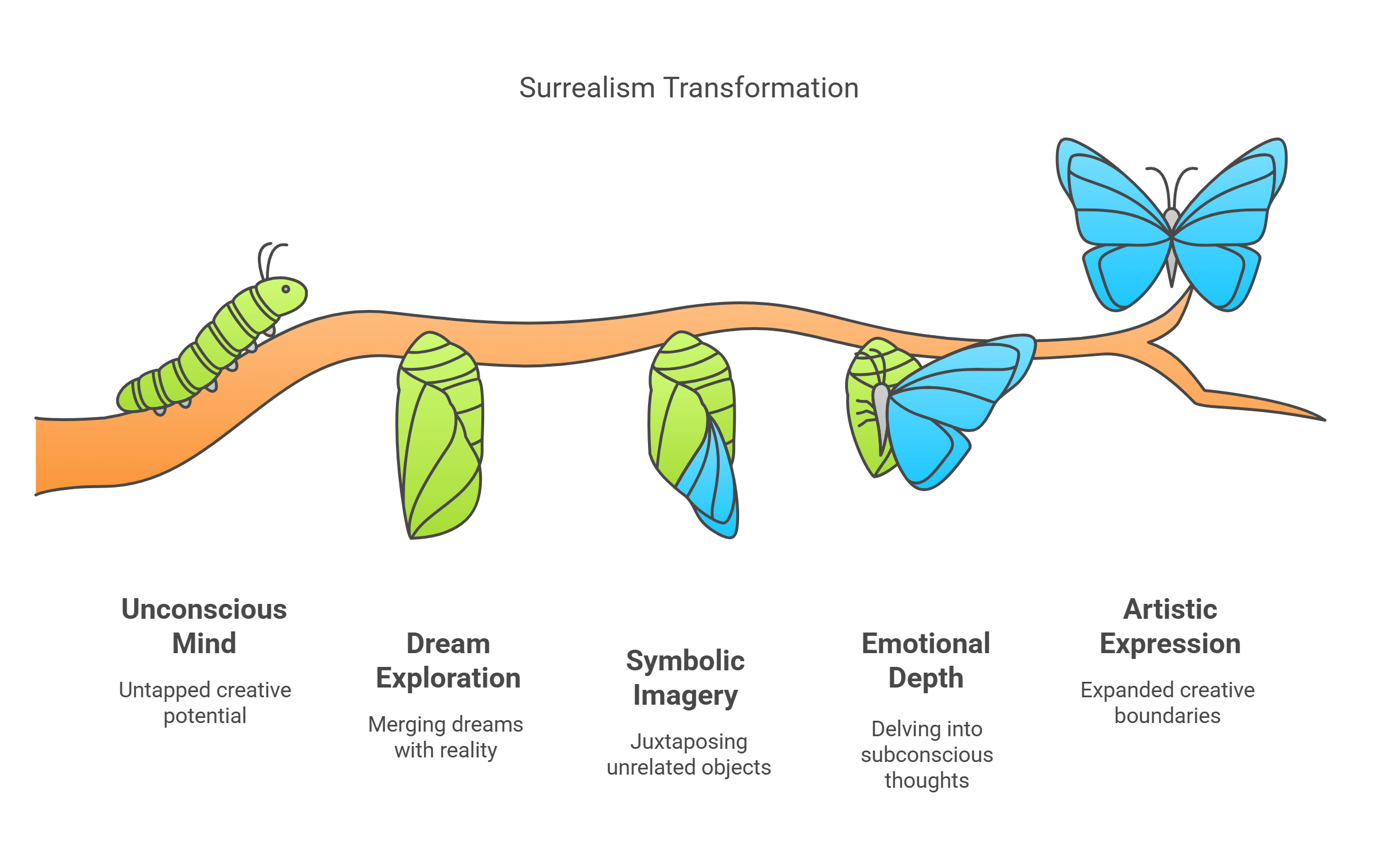
5. Abstract Expressionism
Detailed Explanation: Abstract Expressionism (1940s–1950s) emerged in post-World War II America, emphasizing emotional expression through abstract forms and gestural brushstrokes. It rejected representational art in favor of personal and universal themes.
- Key Characteristics:
- Large-scale canvases filled with dynamic, spontaneous gestures.
- Focus on color, texture, and movement rather than recognizable subjects.
- Two main styles: Action Painting (e.g., Jackson Pollock) and Color Field Painting (e.g., Mark Rothko).
- Famous Artists:
- Jackson Pollock (Autumn Rhythm).
- Mark Rothko (Orange and Yellow).
- Impact:
- Established New York as a center of modern art.
- Redefined art as an act of creation, emphasizing process over product.
Explained Simply: Abstract Expressionism is like pouring raw emotion onto a canvas, letting feelings take shape in abstract forms.
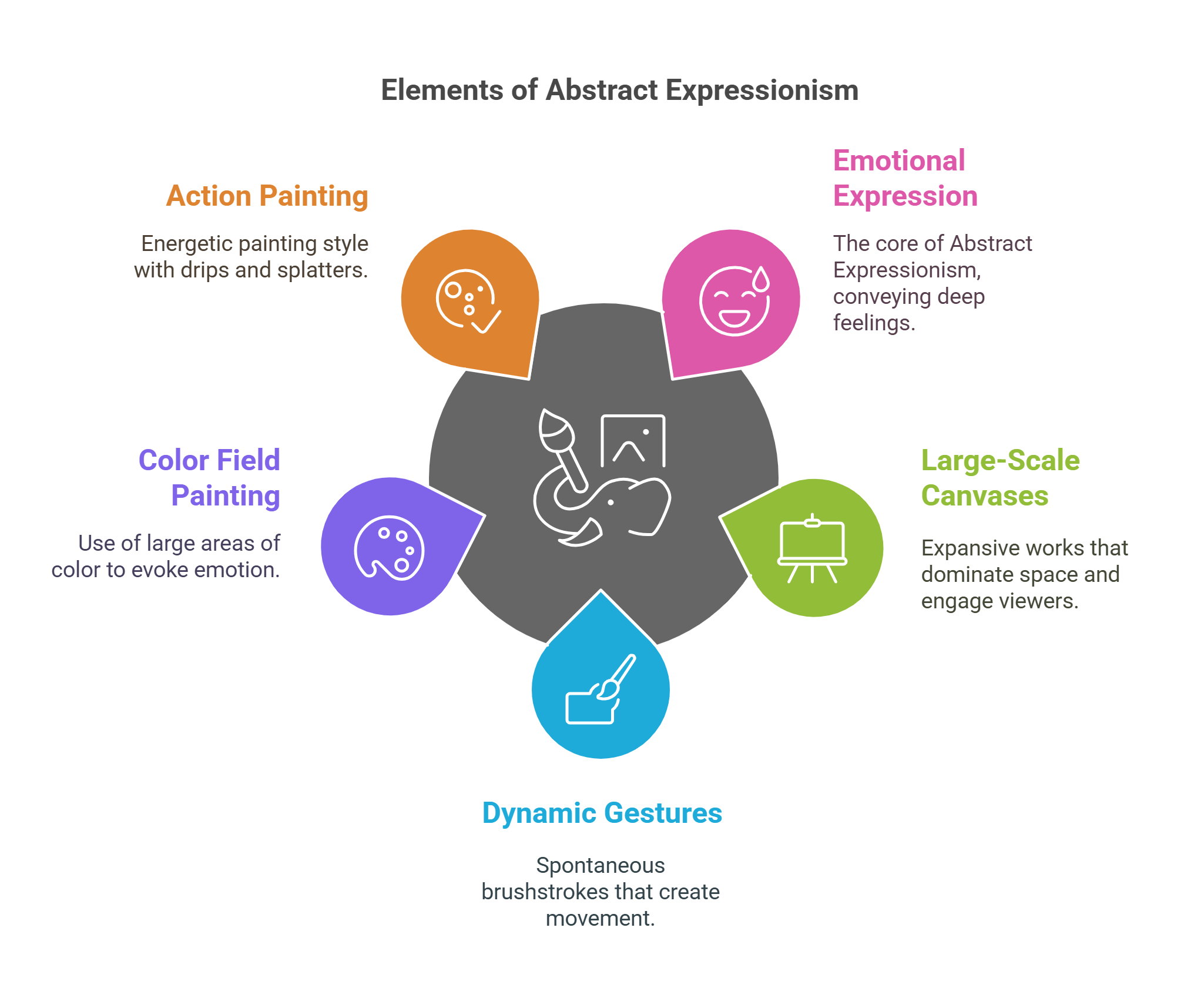
6. Baroque Art
Detailed Explanation: Baroque art (17th–18th centuries) emerged in Europe, characterized by dramatic intensity, grandeur, and movement. It was closely tied to the Counter-Reformation, as the Catholic Church used art to inspire faith and awe.
- Key Characteristics:
- Dramatic contrasts of light and shadow (chiaroscuro).
- Emotional intensity and dynamic compositions.
- Rich detail and elaborate ornamentation.
- Famous Artists:
- Caravaggio (The Calling of St. Matthew).
- Peter Paul Rubens (The Elevation of the Cross).
- Gian Lorenzo Bernini (The Ecstasy of Saint Teresa).
- Impact:
- Influenced architecture, theater, and music.
- Reflected the political and religious tensions of the time.
Explained Simply: Baroque art is like a theatrical performance on canvas, full of drama, emotion, and grandeur.
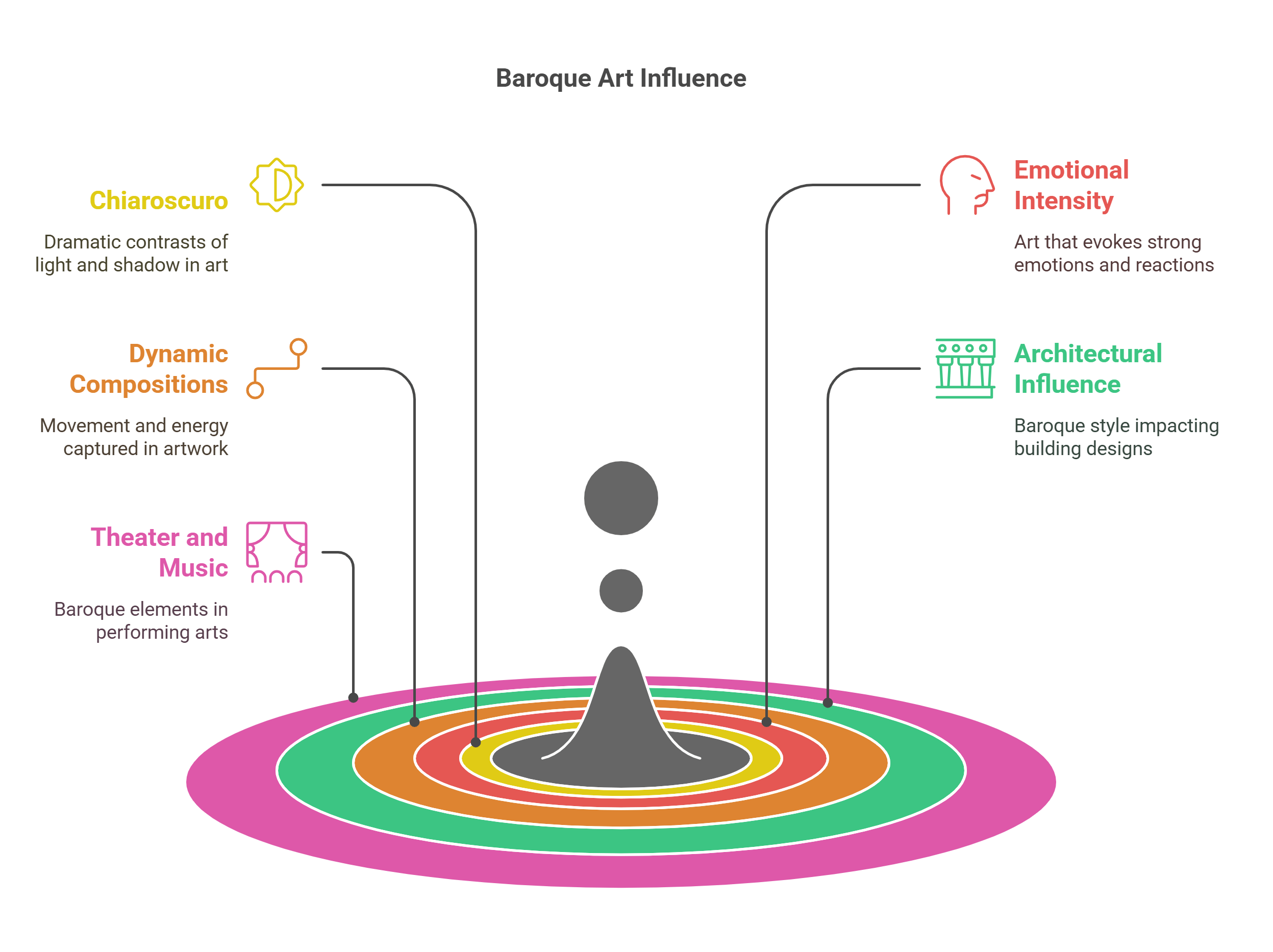
7. Romanticism
Detailed Explanation: Romanticism (late 18th–mid 19th century) celebrated emotion, individualism, and the sublime, reacting against the rationality of the Enlightenment and industrialization. It sought to evoke awe and wonder, particularly in nature and human imagination.
- Key Characteristics:
- Emphasis on intense emotion and personal expression.
- Fascination with nature’s beauty and power.
- Themes of heroism, exoticism, and the supernatural.
- Famous Artists:
- Caspar David Friedrich (Wanderer above the Sea of Fog).
- Francisco Goya (The Third of May 1808).
- J.M.W. Turner (The Fighting Temeraire).
- Impact:
- Inspired nationalism and individual freedom in art and literature.
- Influenced later movements like Impressionism and Symbolism.
Explained Simply: Romanticism is like capturing the soul’s deepest feelings on canvas, whether inspired by a stormy sea or a lone wanderer.
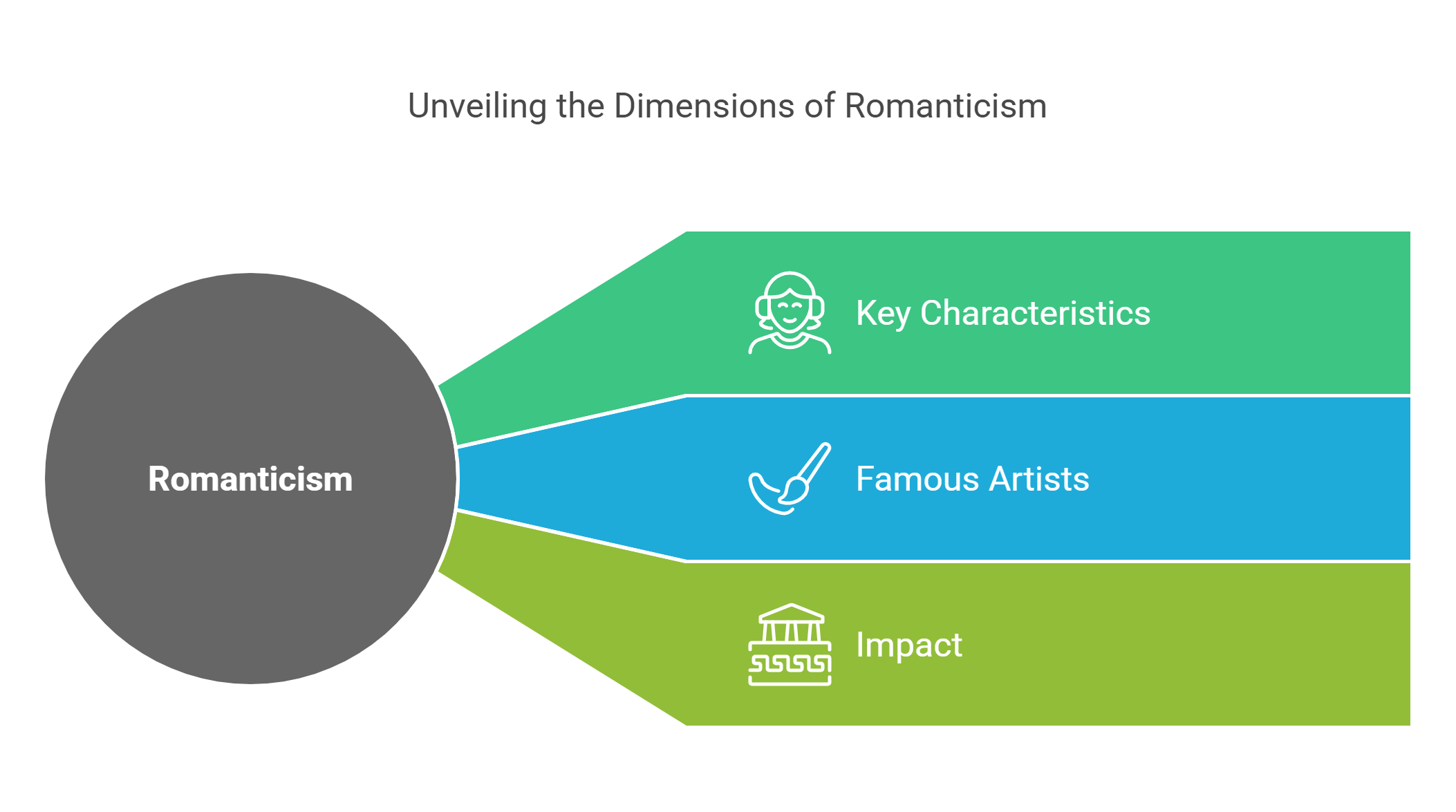
8. Contemporary Art
Detailed Explanation: Contemporary art encompasses a wide range of styles and media from the late 20th century to the present. It often engages with current issues, challenging traditional boundaries and encouraging viewer interpretation.
- Key Characteristics:
- Use of diverse media, including digital art, installations, and performance.
- Focus on themes like identity, globalization, and environmental issues.
- Often participatory, inviting audience interaction.
- Famous Artists:
- Yayoi Kusama (Infinity Mirror Rooms).
- Banksy (graffiti works like Girl with a Balloon).
- Ai Weiwei (Sunflower Seeds).
- Impact:
- Reflects the complexities of the modern world.
- Encourages dialogue about societal issues.
Explained Simply: Contemporary art is like a conversation between artists and audiences, exploring the pressing questions of today.
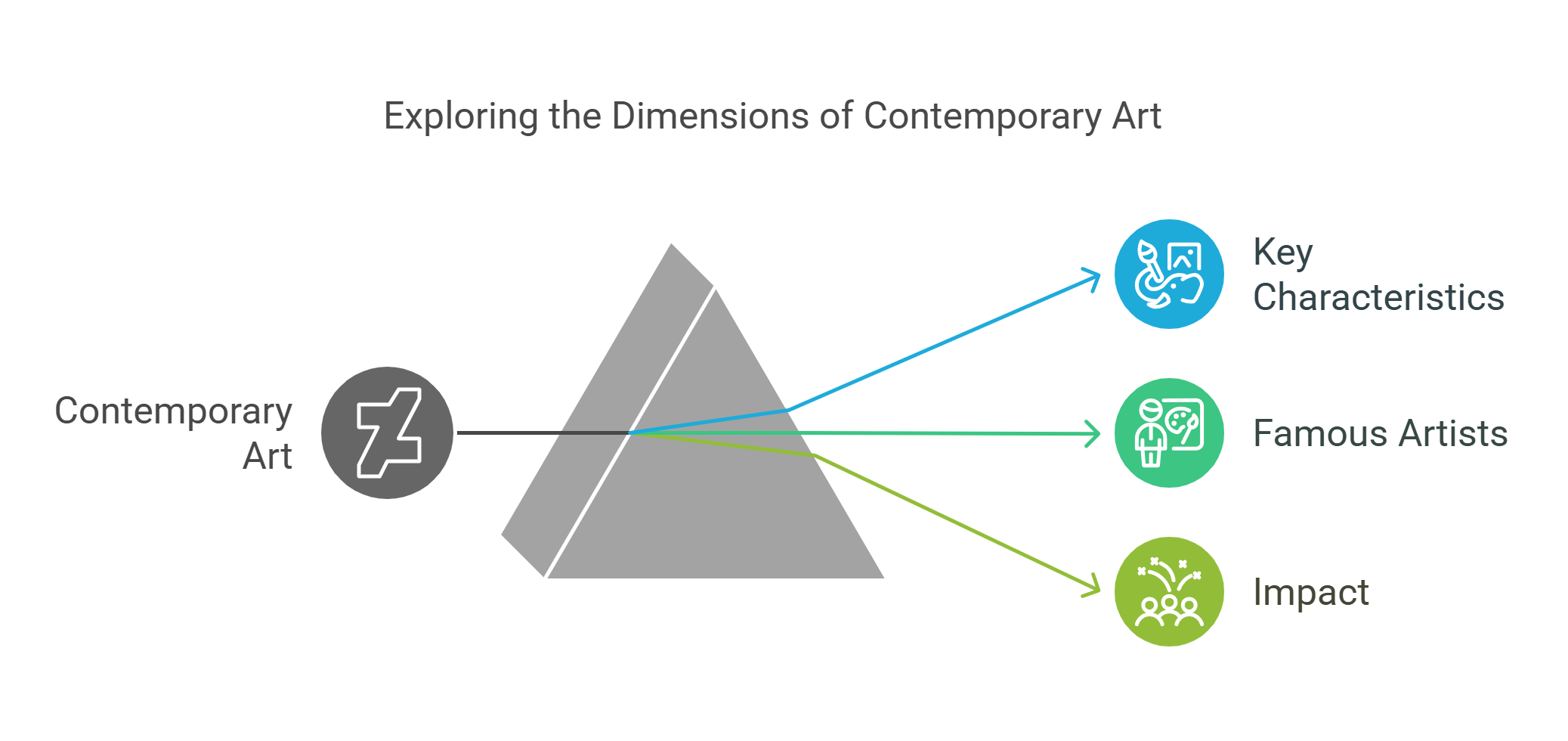
9. Art Criticism
Detailed Explanation: Art criticism is the analysis, interpretation, and evaluation of art, helping audiences understand and appreciate works more deeply. Critics often consider context, technique, and meaning in their assessments.
- Key Components:
- Description: What does the artwork depict?
- Analysis: How are elements like color, composition, and texture used?
- Interpretation: What is the intended message or theme?
- Judgment: Is the artwork successful in its goals?
- Impact:
- Shapes public perceptions and cultural values about art.
- Influences trends and movements in the art world.
Example: John Ruskin’s critiques in the 19th century shaped the reputation of artists like J.M.W. Turner.
Explained Simply: Art criticism is like reading between the brushstrokes, uncovering the deeper story behind a work.

10. Non-Western Art Traditions
Detailed Explanation: Non-Western art traditions encompass the rich and diverse artistic expressions of cultures outside the European canon, such as African, Asian, Indigenous, and Islamic art. These traditions often reflect unique cultural, religious, and historical contexts.
- Key Traditions:
- African Art: Focus on symbolism, community, and spirituality (e.g., Benin bronzes, masks).
- Islamic Art: Geometric patterns, calligraphy, and architecture (e.g., Alhambra, Quranic manuscripts).
- Asian Art: Emphasis on harmony with nature, such as in Chinese landscape painting and Japanese woodblock prints.
- Indigenous Art: Storytelling through totems, sand paintings, and textiles.
- Impact:
- Challenges Eurocentric narratives in art history.
- Highlights the interconnectedness of global artistic traditions.
- Key Traditions:
Example: The influence of Japanese ukiyo-e prints on Impressionist artists like Vincent van Gogh demonstrates cross-cultural exchanges.
Explained Simply: Non-Western art traditions are like a kaleidoscope of creativity, reflecting the unique stories of diverse cultures.
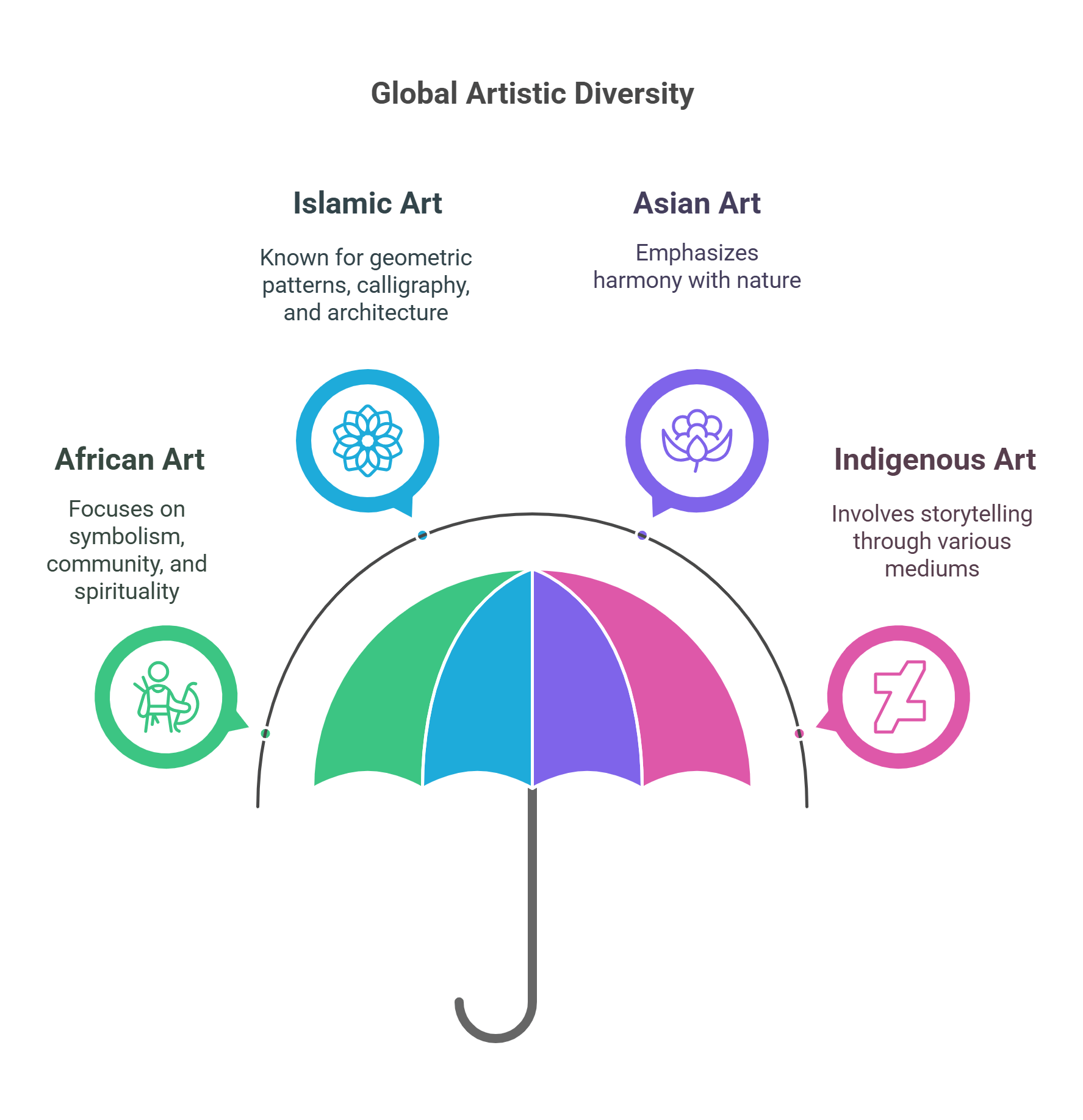
✨ Conclusion
The history of art showcases humanity’s evolving creativity, reflecting cultural, political, and philosophical shifts across time. By exploring concepts like Renaissance art, Romanticism, and non-Western traditions, readers can critically analyze RC passages and appreciate the global tapestry of artistic expression.










